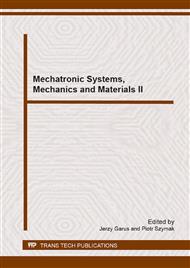[1]
S. R. Best and D. L. Hanna: A performance comparison of fundamental small-antenna designs, IEEE Antennas Propagation Magazine (2010), vol. 52, no. 1, p.47–70.
DOI: 10.1109/map.2010.5466398
Google Scholar
[2]
R. C. Hansen in: Electrically Small, Superdirective, and Superconducting Antennas. NJ: Wiley, (2006).
DOI: 10.1002/0470041048.ch2
Google Scholar
[3]
H. R. Stuart: Electrically small antenna elements using negative permittivity resonators, IEEE Trans. Antennas Propag., vol. 54, no. 6, p.1644–1653, (2006).
DOI: 10.1109/tap.2006.875498
Google Scholar
[4]
H. Choo., R. L Rogers., H. Ling: Design of Electrically Small Wire Antennas Using a Pareto Genetic Algorithm, IEEE Trans. Antennas Propag., vol. 53, No. 3, (2005).
DOI: 10.1109/tap.2004.842404
Google Scholar
[5]
Yifeng Fan, Rajab Khalid Z., Munoz M, Yang Hao, Electrically small half-loop antenna design with Non-Foster matching networks, 6th European Conference on Antennas and Propagation(EUCAP), 2011, pp.126-129.
DOI: 10.1109/eucap.2012.6206602
Google Scholar
[6]
Haiyu Huang, Karl Nieman: Electrically small folded ellipsoidal helix antenna for medical implant applications, Antennas and Propagation, 2011 IEEE International Symposium on, pp.769-771.
DOI: 10.1109/aps.2011.5996826
Google Scholar
[7]
H. A. Wheeler: Small antennas, IEEE Trans. Antennas Propagat., vol AP-23 (1975), p.462.
DOI: 10.1109/tap.1975.1141115
Google Scholar
[8]
L. J. Chu: Physical limitations of omni-directional antennas, Journal of Applied Physics(1948), vol. 10, p.1163–1175.
DOI: 10.1063/1.1715038
Google Scholar
[9]
H. W. Bode: Network Analysis and Feedback Amplifier Design, New York: Van Nostrand Company, (1945).
Google Scholar
[10]
R. M. Fano: Theoretical limitations on the broad-band matching of arbitrary impedances, J. Franklin Inst., vol. 249, pp.139-154, (1950).
DOI: 10.1016/s0016-0032(50)91101-x
Google Scholar
[11]
S.E. Sussman-Fort, Non-Foster Impedance Matching of Electrically-Small Antennas, IEEE Transactions On Antennas And Propagation (2009), Vol. 57, No. 8.
DOI: 10.1109/tap.2009.2024494
Google Scholar
[12]
J.T. Aberle and R. Loepsinger-Romak: Antennas with Non-Foster Matching Networks, C.A. Balanis: Synthesis Lecture on Antennas Series, edited by Morgan & Claypool(2006).
DOI: 10.1007/978-3-031-01532-8_1
Google Scholar
[13]
A. Kaya, E. Y. Yuksel,: Investigation of a compensated rectangular microstrip antenna with negative capacitor and negative inductor for bandwidth enhancement, IEEE Transactions on Antennas and Propagation (2008), vol. 55, pp.1275-1282, (2008).
DOI: 10.1109/tap.2007.895618
Google Scholar
[14]
K. Jagodzińska, S. Dziura, A. Witenberg, M. Walkowiak: ESAs design and measurement, Polish Journal of Environmental Studies, vol. 20, No. 5a (2011), pp.66-69.
Google Scholar


